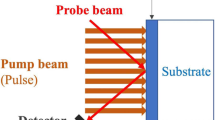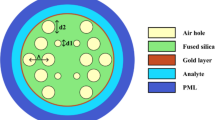Abstract—
The authors propose to use the K-nearest neighbor (K-NN) algorithm to process the probe signals from the previously proposed Brillouin optical time-domain reflectometry (BOTDR) fiber sensor called the differential cross-spectrum BOTDR (DCS-BOTDR), which features a high spatial resolution. Widening of the Brillouin gain spectrum (BGS) when the pulse duration TL is set shorter than the phonon lifetime (~10 ns) is a key problem associated with the DCS-BOTDR. Although the spectrum distortion is reduced also, deterioration in the Brillouin frequency shift (BFS) resolution is observed, which is caused by the broadening of the Brillouin spectrum. On the other hand, while the TL duration exceeding the steady state of the Brillouin signal narrows the spectrum, sidelobes are produced within the steady-state range, which result in the deterioration of the BFS resolution. This limitation is observed only in the DCS-BOTDR, although it is capable of measuring with a high spatial resolution. The experimental data obtained for a fiber with a length of ~400 m and with optimized TL duration in the temperature range of 40–80°C were used in our model to extract the Brillouin temperature coefficient CT. Ideal BGSs were then constructed in the training phase by simulation with different linewidths of 50–70 MHz in order to train the K-NN model with due account for the linewidth variation caused by the difference in the conditions between the training and testing phases. The model was thereby made flexible for various fiber conditions. Experimental data for the sensing of a ~3.6-km-long fiber with TL = 60 ns were used in the testing phase to obtain the temperature distribution. By employing K-NN, the accuracy in determining the temperature for TL = 60 ns has been improved to approximately 2.77°C. Therefore, the K-NN model can be an excellent alternative tool for processing BGSs measured by the DCS-BOTDR and obtaining the temperature distribution along the fiber.










Similar content being viewed by others
REFERENCES
Bai, Q., Wang, Q., Wang, D., Wang, Y., Gao, Y., Zhang, H., Zhang, M., and Jin, B., Sensors, 2019, vol. 19, p. 1862. https://doi.org/10.3390/s19081862
Bao, X. and Chen, L., Sensors, 2012, vol. 12, p. 8601. https://doi.org/10.3390/s120708601
Hartog, A.H., An Introduction to Distributed Optical Fibre Sensors, CRC Press, 2017. https://doi.org/10.1201/9781315119014
Almoosa, A.S.K., Hamzah, A.E., Zan, M.S.D., Ibrahim, M.F., Arsad, N., and Elgaud, M.M., Opt. Fiber Technol., 2022, vol. 70, p. 102860. https://doi.org/10.1016/j.yofte.2022.102860
Zan, M.S.D., et al., Opt. Fiber Technol., 2022, vol. 72, p. 102977. https://doi.org/10.1016/j.yofte.2022.102977
Zan, M., et al., J. Phys.: Conf. Ser., 2021, vol. 1892, p. 012034. https://doi.org/10.1088/1742-6596/1892/1/012034
Koyamada, Y., Sakairi, Y., Takeuchi, N., and Adachi, S., IEEE Photonics Technol. Lett., 2007, vol. 19, p. 1910. https://doi.org/10.1109/LPT.2007.908651
Nishiguchi, K.I., Li, C.-H., Guzik, A., and Kishida, K., Sensors, 2014, vol. 14, p. 4731. https://doi.org/10.3390/s140304731
Horiguchi, T., Masui, Y., and Zan, M.S.D., Sensors, 2019, vol. 19, p. 1497. https://doi.org/10.3390/s19071497
Shibata, R., Kasahara, H., Elias, L.P., and Horiguchi, T., IEICE Electron. Express, 2017, vol. 14, no. 11, p. 20170267 https://doi.org/10.1587/elex.14.20170267
Zan, M.S.D., Masui, Y., and Horiguchi, T., Proc. 2018 IEEE 7th Int. Conference on Photonics (ICP), Langkawi, 2018, p. 1. https://doi.org/10.1109/ICP.2018.8533208
Bansal, M., Goyal, A., and Choudhary, A., Decis. Anal. J., 2022, vol 3, p. 100071. https://doi.org/10.1016/j.dajour.2022.100071
Chaplot, N., Dhyani, P., and Rishi, O., Int. J. Comput. Sci. Eng. Technol., 2013, vol. 1, p. 12. Corpus ID 173168717
Nordin, N.D., Zan, M.S.D., and Abdullah, F., Opt. Fiber Technol., 2020, vol. 58, p. 102298. https://doi.org/10.1016/j.yofte.2020.102298
Funding
Section 1 was prepared under State Assignment no. AAAA-A19-119042590085-2.
Author information
Authors and Affiliations
Corresponding authors
Ethics declarations
The authors declare that they have no conflicts of interest.
Additional information
Translated by N. Goryacheva
International Conference “Optical Reflectometry, Metrology, & Sensing,” Russia, Perm, May 24–26, 2023.
Rights and permissions
About this article
Cite this article
Almoosa, A.S., Zan, M.S., Ibrahim, M.F. et al. Enhancing the Temperature-Measurement Efficiency in the Brillouin Optical Time-Domain Reflectometry (BOTDR) Fiber Sensor with the K-nearest Neighbor (K-NN) Algorithm. Instrum Exp Tech 66, 745–752 (2023). https://doi.org/10.1134/S0020441223050275
Received:
Revised:
Accepted:
Published:
Issue Date:
DOI: https://doi.org/10.1134/S0020441223050275




